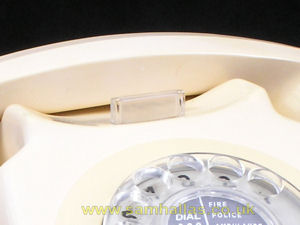
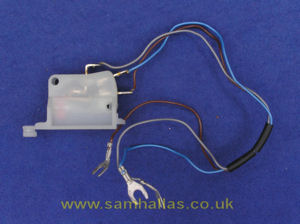
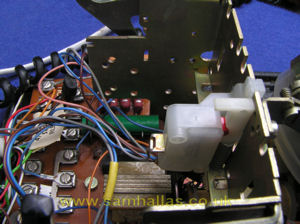

Sam Hallas' Website



The most common accessory is a single press button, Fig 19, above left, either as a PBX recall or bell on/ off switch. to reduce the stock requirements, all the buttons are transparent avoiding the need for different colours. The single button for these applications fits in the slot vacated by the blanking plate and is held in place by two pins pressed into the slots.
A momentary action switch, for recall on a PBX or call exchange for shared service, is typically provided by the Switch 5A-4, Fig 20, above centre, which is a microswitch in a custom moulding to fit the slots on the 746's support bracket as in Fig 21, above right. A nylon actuating plunger, Fig 22, below left, is used to operated the switch. It earned the nickname of "Zebedee" presumably from the Z-shape and the similarity to the jack-in-the box character from The Magic Roundabout.

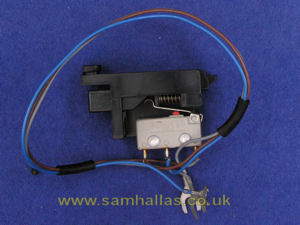
For a latching action, eg for bell on/ off, a Switch 23A-1 can be used which has an integral operating plunger and a cunning latch mechanism. (Fig 23 right)
The main support bracket is also used on the Telephone No 740. This is why there are additional slots on the bracket.
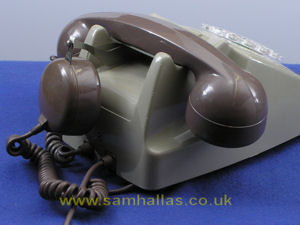
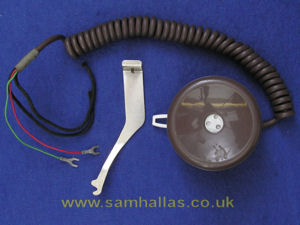
A second receiver could be used for a second person to listen to a call whilst taking notes. Alternatively those with hearing disability find it an advantage to use both ears on a call. The bracket seen in Fig 25 fits into the carry handle recess and is fixed by a screw through one of the holes seen in Fig 7.
The Engineering Instruction A1076 (Ref 1) speaks of add-on units and adapters in separate Instructions. Some are identical to those used on the 706. A list is contained in N848 For more accesories see the Appendix
Additional gravity springsets can be fitted for use with extension plans and PMBX No 2. Because of the different design of the main support bracket, these differ from those for the 706.
The variants of the Handset No 3 can be fitted: Handsets 4 & 5 with built-in amplifier, Handset No 6 with a press button and Handset No 7 with a neon lamp.
An adapter was produced to allow the Tele 746 to be mounted upside down on a wall like the similar arrangement for the Tele 706. It's rather cumbersome and was limited in application to the push buttons versions, Tele 765, 783, 785. A photograph can be seen at Britishtelephones.com
Dial blanking plates were available for certain applications such as telephones connected to a switchboard in a public area of a hotel where dialling out might not be allowed.
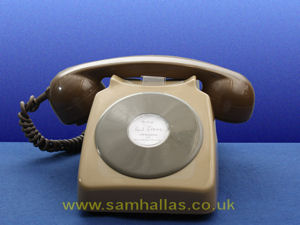
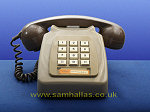
In the late 1960s push button versions were produced using the same basic cover. The button unit was designed to fit in the circular aperture for the dial with a special surround.
Models were made for pulse dialling, tone (DTMF) dialling and with a 10-number store.
Initially the DTMF models were for use on private exchanges, but by 1977 the Telephone No 782 was introduced for the public network.
Telephone No 746 was a worthy successor to the pioneering Telephone No 706 which introduced plastics to Post Office Telephones. It brought valuable improvements in design and was cheaper to produce from both component cost and assembly time.
Telephone No 746 was the last of the mass-market, non-electronic telephones produced for rental by the Post Office. It lasted in service until the 1980s when liberalisation of the telephone market, advances in electronic telephones and British Telecom discontinuing rental made it obsolete. For longevity it beat its parent 706 and rivalled the bakelite wonder, the 300 series of telephones.
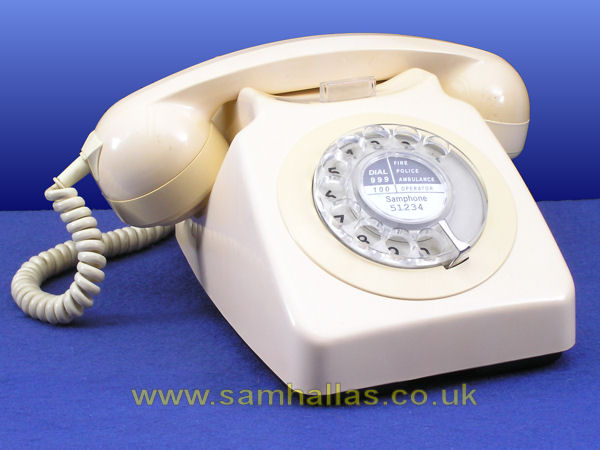
Next is the Telephone No 740 which has provision for up to four buttons.
1. Telephones Nos 746 and 8746 at Britishtelephones.com
http://www.britishtelephones.com/t746.htm
2. Planphone A at Britishtelepones.com
http://www.britishtelephones.com/plans625.htm
Thanks to Kevin Dodman, Andrew Tebbutt, Geoff Mawdsley, Bob Freshwater, Norman Josling, Jack Ryan, Adrian Rodsett and other members of the Telecomms Heritage Group for advice and help.
 Previous
Tele 740
Previous
Tele 740